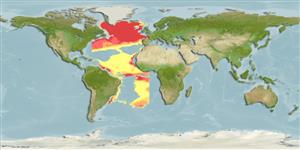>
Gadiformes (Cods) >
Macrouridae (Grenadiers or rattails)
Etymology: Coryphaenoides: Greek, koryphaina = dolphin fish + Suffix oides = similar to (Ref. 45335).
More on authors: Goode & Bean.
Environment: milieu / climate zone / depth range / distribution range
Ökologie
seewasser bathypelagisch; tiefenbereich 430 - 4700 m (Ref. 58426), usually ? - 2400 m (Ref. 117245). Deep-water; 65°N - 40°S, 70°W - 1°W
Northeast Atlantic: east of southern Greenland southward to the Azores; Irish continental slope to the Bay of Biscay and off northern Spain. Reported from Iceland (Ref. 12462). Western Atlantic off the coasts of North America.
Size / Gewicht / Alter
Maturity: Lm ? range ? - ? cm
Max length : 35.0 cm TL Männchen/unbestimmt; (Ref. 6187)
Kurzbeschreibung
Morphologie | Morphometrie
Mandible with a single row of teeth. Spinules or scales disposed in slightly diverging rows. Head scaled except for gular and branchiostegal membranes, lower surface of snout and sub orbital region, lunate area on either side of the snout. Body pale brown, lips, lining of gill cavities and peritoneum blackish (Ref. 37108).
Bathypelagic (Ref. 58426). Feeds on small crustaceans (Ref. 6187) and worms (Ref. 58426).
Life cycle and mating behavior
Geschlechtsreife | Fortpflanzung | Ablaichen | Eier | Fecundity | Larven
Cohen, D.M., T. Inada, T. Iwamoto and N. Scialabba, 1990. FAO species catalogue. Vol. 10. Gadiform fishes of the world (Order Gadiformes). An annotated and illustrated catalogue of cods, hakes, grenadiers and other gadiform fishes known to date. FAO Fish. Synop. 125(10). Rome: FAO. 442 p. (Ref. 1371)
IUCN Rote Liste Status (Ref. 130435)
Bedrohung für Menschen
Harmless
Nutzung durch Menschen
Mehr Information
NamenSynonymeMetabolismusRäuberÖkotoxikologieFortpflanzungGeschlechtsreifeAblaichenSpawning aggregationFecundityEierEientwicklung
ReferenzenAquakulturAquakultur ProfilZuchtlinienGenetikElectrophoresesVererbbarkeitKrankheitenVerarbeitungNutrientsMass conversion
PartnerBilderStamps, Coins Misc.LauteCiguateraGeschwindigkeitSchwimmstilKiemenoberflächeOtolithsGehirngrößeSehfähigkeit
Tools
Zusatzinformationen
Download XML
Internet Quellen
Estimates based on models
Preferred temperature (Ref.
123201): 2.6 - 4.2, mean 3.2 °C (based on 1231 cells).
Phylogenetic diversity index (Ref.
82804): PD
50 = 0.5000 [Uniqueness, from 0.5 = low to 2.0 = high].
Bayesian length-weight: a=0.00219 (0.00111 - 0.00431), b=3.20 (3.03 - 3.37), in cm total length, based on LWR estimates for this (Sub)family-body shape (Ref.
93245).
Trophic level (Ref.
69278): 3.5 ±0.44 se; based on food items.
Widerstandsfähigkeit (Ref.
120179): niedrig, Verdopplung der Population dauert 4,5 - 14 Jahre. (Preliminary K or Fecundity.).
Fishing Vulnerability (Ref.
59153): Low vulnerability (25 of 100).
